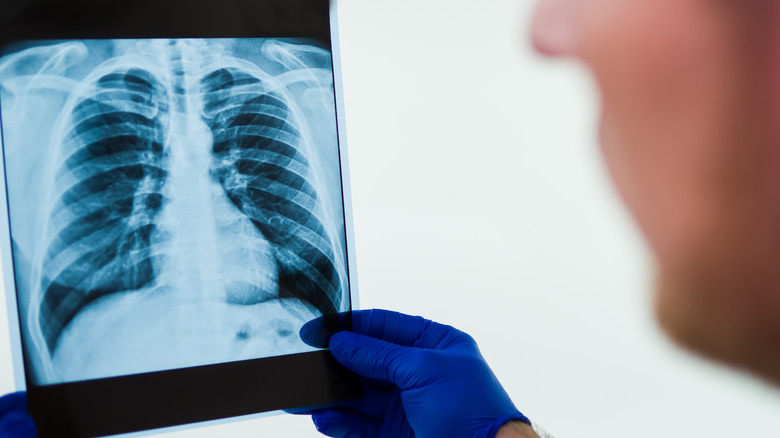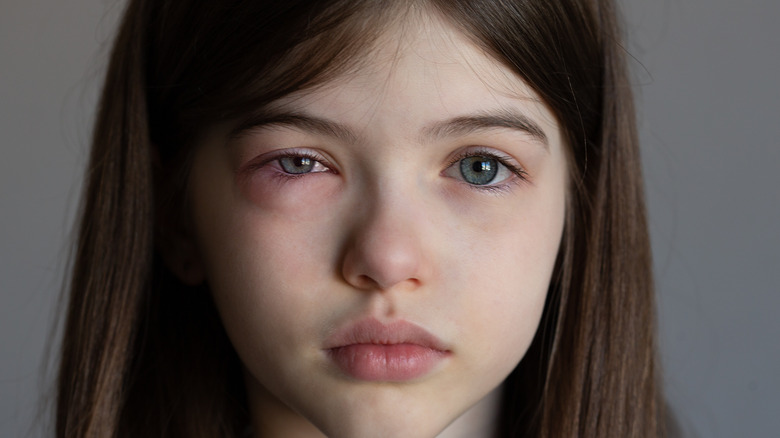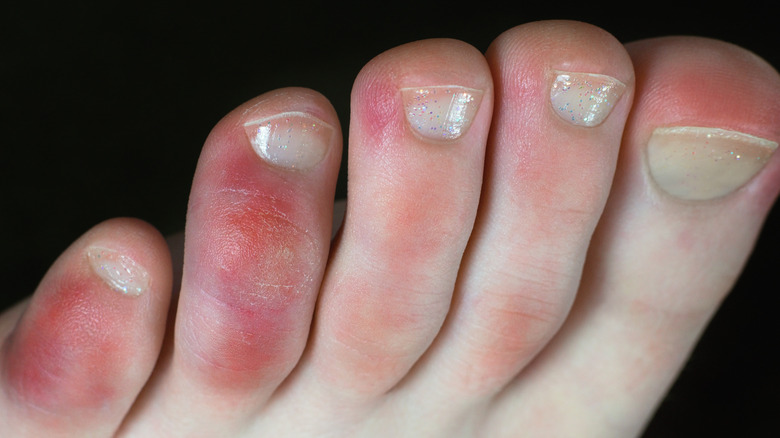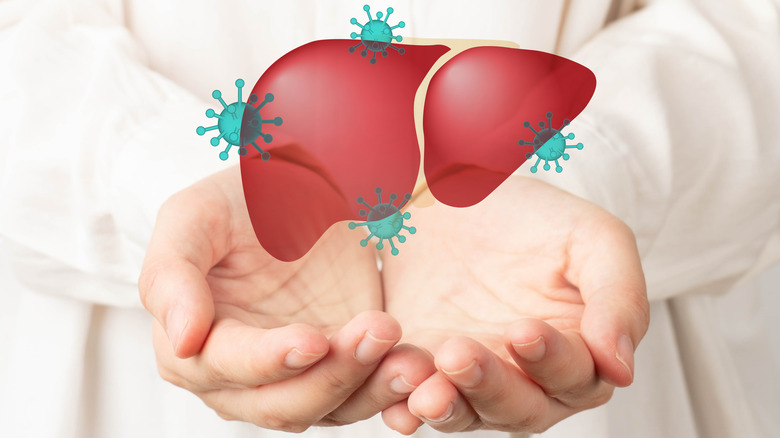Unusual Ways COVID-19 Can Affect Your Body
By now, you're likely painfully aware of the primary symptoms of COVID-19. Fever, dry cough, fatigue, sore throat, shortness of breath — if you haven't been there, done that, chances are you know a few people who have. And if you have a school-aged kid, you're probably also aware that pretty much everything is a COVID symptom (because you took your kid on a weekend hike just to get the poor thing out of the house and the next day he woke up sore from the unaccustomed exercise and then got sent home from school for 10 days because "body aches" are a COVID symptom).
Sounds alarmist, but the truth is that COVID does have a lot of bizarre symptoms that you wouldn't necessarily expect to see in a coronavirus. If you've had the common cold, you've probably had coronavirus 229E, HKU1, or OC43 (via the CDC), which means you're all too familiar with base coronavirus symptoms like cough, congestion, and sore throat. But COVID was clearly not content with just being a worse version of the common cold. It had to up the ante with all of these unusual but very real things it can do to the bodies it invades.
Anosmia and ageusia
Let's just talk about this one right up front, because it is one of COVID-19's most famous symptoms. "Anosmia and ageusia" just means "loss of taste and smell" — and in COVID, this symptom is unusual because it's not the same thing you'd experience if you had the common cold.
With the common cold, congestion is the culprit. You can't smell because you can't inhale through your nose, and you can't taste because you can't smell. With COVID, though, you can have a loss of taste and smell even without congestion. It usually comes on suddenly and can be one of the first symptoms of the disease. And medical professionals still aren't sure what causes it.
A 2022 Nature Genetics study found that there may be a genetic component to this symptom, which explains why some people experience it and some people don't. Researchers found that people of East Asian and African American ancestry were a lot less likely to experience a loss of taste and smell than people of European ancestry. They were also able to narrow the culprit down to two genes responsible for metabolizing smells that express themselves in the lining of the nasal cavity.
Brain fog
You probably expect to feel a little out of it when you get sick. After all, you don't sleep very well and you don't have a lot of energy, so it makes sense that your brain wouldn't be as sharp as it is when you're healthy. But COVID brain fog is something completely different.
Brain fog is a frequently described symptom of both active COVID and long COVID, the latter of which is the common term for COVID symptoms that linger long after the virus has been cleared from the body. A 2021 study published in the Journal of Experimental Medicine found evidence that SARS-CoV-2, the virus that causes COVID-19, can invade the brain and replicate there. And it's even worse than that: Once there, the oxygen-hungry replication process steals O2 from healthy cells and creates low-oxygen areas in the brain, which ultimately leads to the death of nearby nuerons.
So it's probably accurate to say that COVID brain fog isn't just something that happens because you're feeling beaten down by your illness — it's literally something that happens because SARS-CoV-2 is killing brain cells.
Erectile dysfunction
It's probably safe to say that a lot of males would rather lose brain cells than below-the-belt virility, so it's worth shouting this one from the rooftops: COVID-19 can cause long-term erectile dysfunction (ED).
A 2021 review published in Sexual Medicine Reviews found strong evidence that COVID-19 infection is significantly associated with erectile dysfunction, though the authors say there may also be a number of outside contributing factors including stress, anxiety, and weight gain brought on by lockdowns, loss of employment, and other pandemic-related variables.
Don't be tempted to dismiss the high prevalence of ED in recovered COVID-19 patients as being completely external, though. The authors also said that impaired vascular function and a decrease in testosterone levels are two effects that may be directly related to COVID-19 infection and are strongly associated with ED. There is also evidence that the virus's effect on testicular tissue could be long-term, so it might not even be something you'll get over as you recover from the virus. So if you're male and you're still on the fence about getting vaccinated, well, there you go.
Hearing loss and tinnitus
This symptom is unusual and not super common, and to be fair, studies looking into it tend to be kind of small. One of these studies — published in Acta Oto-Laryngologica in 2021 — tested the hearing of people before, during, and after infection with COVID-19, and found significant hearing loss at 1000 Hz, which is the frequency where you hear certain speech sounds (via Hearing Health & Technology Matters). If you can't hear well at 1000 Hz, you're probably not picking up on fricatives like "f" and "th" or plosives like "t," "k," "p," "d," "g," and "b." So, kind of important.
Another study published in the Journal of Modern Rehabilitation looked at COVID-19 patients between the ages of 25 and 45 and found that 5% of them experienced vertigo, 2.7% of them had tinnitus (ringing in the ears), and another 2.7% of them had hearing loss. Fortunately, almost all of the patients reporting these symptoms during active COVID did not continue to experience them after recovery. The authors also noted that the symptoms could have been caused by stress or medication, so larger studies need to be done to confirm and possibly explain the findings.
Blood clots and problems with blood vessels
Some of the scarier effects of COVID-19 infection are the ones that affect the vascular system. A 2022 study published in Plos One found that having COVID-19 doubles your risk of venous thrombosis compared to people who have the flu or are in the hospital for some other reason. In simple terms, this means COVID-19 may cause blood clots that block your veins. These clots can be especially dangerous when they break free and end up in your lungs. If you have COVID, your risk of this happening is especially elevated if you are male, older, or you have diabetes.
Another study published in Medicina Clínica in 2021 found that 106 hospitalized COVID-19 patients out of 2,943 developed symptomatic vascular thrombosis, and 25 of those patients (23.58%) died. The study doesn't say if thrombosis was the direct cause of each death, but it does point to a significantly higher risk of mortality in COVID-19 patients who develop this complication.
Hair loss
Humans can be pretty vain about their hair. Pretty much everyone (except maybe The Rock) values a full head of hair, whether it's curly, straight, or somewhere in between. So hair loss after COVID can be pretty shocking and upsetting when it happens.
A study published in the Journal of Drug Delivery & Therapeutics looked at 10 patients with a median age of 21 who developed a scalp condition called telogen effluvium around two months after recovering from COVID-19. Telogen effluvium is a condition where the roots of your hair prematurely go into the resting state. According to DermNet NZ, the condition leads to hair loss and usually happens after some kind of shock to the system. Still, the patients in the study weren't especially sick with COVID-19 — none of them were hospitalized and each one was considered fully recovered from the illness.
In patients with long COVID, hair loss does not seem to be at all uncommon. In fact, a study published in Advances in Health Sciences Research found that 20% of long COVID patients listed hair loss as one of their lingering complaints.
Pink eye
Remember when you were a kid and you got a nasty case of "pink eye?" This condition can glue your eyes shut — not permanently, but enough to seriously freak out your 8-year-old self.
Well, as it turns out, conjunctivitis may not just be a thing from your childhood (though to be fair, it isn't just kids who get bacterial or viral conjunctivitis, as adults can get it too). It is also a known COVID symptom, and in some cases may even be the first or only symptom of the disease.
A study published in Medical Principles and Practice found that 15 out of 121 patients who tested positive for COVID-19 had conjunctivitis and other COVID symptoms, but another three had conjunctivitis and no other symptoms through the entire course of the disease. This means that this uncommon manifestation of COVID could easily be dismissed as a simple eye infection, which could lead to unintentional spread of COVID. Of course, it's also worth noting that if you have any of the very contagious viral and bacterial versions of conjunctivitis, you really ought to be staying home anyway.
Heart problems
COVID-19 can be especially dangerous for people who are elderly and/or have chronic heart disease. In fact, a study published in Immunity, Inflammation and Disease found that a history of chronic heart disease increased the risk of severe COVID-19 by more than 56 times.
Another study (published in the Annals of Noninvasive Electrocardiology) looked at heart function in patients after recovery from COVID-19. The patients in the study group did not have critical disease — in other words, they were not hospitalized and never had to receive oxygen. Researchers still found evidence of impaired heart function in all members of the study group (as compared to the control group, who had not previously had COVID).
COVID is still new enough that it isn't really known how these problems will affect patients in the long term. According to the British Journal of General Practice, between 15% and 50% of long COVID patients report symptoms of postural tachycardia syndrome (POTS), which causes increased heart rate and heart palpitations when switching from a seated or prone to standing position.
Severe confusion or delirium
You've probably used the word "delirious" flippantly to describe your state of mind before your morning cup of coffee, but in medical terms, "delirium" is a mental state characterized by disorganized thinking, inattention, and confusion. According to a 2021 paper published in Revista Brasileira de Terapia Intensiva, delirium appears in up to 25% of COVID-19 patients over the age of 65, and in more than two thirds of severe COVID-19 patients. This is often an effect of hypoxia, a state of severe oxygen deprivation that can occur when SARS-CoV-2 attacks the lungs.
Research has shown that delirium isn't just something that happens to elderly patients. Delirium in pediatric patients may happen in as many as 66% of cases (though the range goes all the way up from .84%, so it's safe to say researchers don't have any reliable numbers just yet). Just like with adult patients, kids under the age of five are more likely to experience delirium when they are critically ill. No matter who the patient is, delirium is associated with poor outcomes, so it's definitely not a point you ever want to get to when you are sick with COVID-19.
COVID toes
COVID is usually thought of as a respiratory illness, so symptoms that appear in other parts of the body can seem pretty strange. Perhaps none of these peculiar symptoms are quite as odd as COVID toes, since the toes are about as far as you can get from the lungs and seem to be the least likely part of the body to suffer as a result of SARS-CoV-2 infection. And yet ...
COVID toes are basically chilblains, which Scleroderma & Raynaud's UK describes as itchy red patches that sometimes appear on your toes after you've spent time in cold weather. Chilblains are thought to be related to poor circulation, though so far, that doesn't seem to be the reason why people get chilblains-like toe lesions after infection with SARS-CoV-2.
A study published in the British Journal of Dermatology looked at COVID toes in 50 hospitalized patients. It found that changes in the cells that line the small vessels that supply blood to the toes, along with a runaway immune response, may be behind this bizarre and sometimes debilitating symptom. Fortunately, COVID toes aren't forever. Most people recover in a couple of weeks, though it may take longer for some (per the American Academy of Dermatology Association).
Decreased male fertility
The ACE2 receptor is expressed in the lining of blood vessels in the testicles (via Sexual Medicine Reviews). According to the American Journal of Hypertension, the ACE2 receptor also happens to be an entry point for SARS-CoV-2.
Researchers are still debating whether this is what causes the decrease in male fertility that can happen after infection with SARS-CoV-2. According to a review published in Urology, another possibility is that inflammation caused by COVID-19 leads hypogonadism (in other words, impaired function of the testicles and reduced production of testosterone). Some researchers have also suggested that infection with COVID-19 may affect sperm concentration and motility (via Crescent Journal of Medical and Biological Sciences).
Whatever the cause, it's clear that COVID-19 isn't something you want to contract if you're interested in becoming a father any time soon, though there does seem to be some hope that the drop in fertility may be temporary.
Permanent organ damage
When you recover from a bad case of the common cold, norovirus, or even the flu, you can be fairly sure that you'll be back to normal in a couple of weeks at most. But the truth is that some viral infections can cause life-long disability (most people are too young to remember polio), and COVID-19 appears to be one of them.
According to a study published in The BMJ, long COVID might not be a simple case of lingering symptoms that eventually resolve on their own. The study found that people who have been hospitalized for COVID-19 had increased rates of dysfunction in multiple organs, including the lungs, kidneys, liver, and heart. And this wasn't something they saw just in elderly patients, either — younger patients were also at risk.
Fortunately, organ dysfunction was mild in most of the patients in the study. Still, researchers also found that 29% of them had to be readmitted after discharge and a whopping 12% died. Although the reasons for each of these deaths wasn't investigated, other studies have found that COVID patients are often readmitted for things like sepsis, pneumonia, and heart failure (via Journal of the American Medical Association).
Myocarditis
Myocarditis is an inflammation of the heart muscle. Recently, myocarditis has gotten a lot of press as an uncommon side effect of the mRNA COVID-19 vaccine — it happens at a rate of roughly 2 cases per 100,000 vaccinated people (via New England Journal of Medicine). It's also worth noting that this side effect is usually mild to moderate and tends to resolve on its own.
What has gotten less press is that myocarditis can also happen after infection with the SARS-CoV-2 virus itself. When it does occur, it tends to be a sign of severe disease.
A small study that appeared on the preprint server medRxiv found that of 84 hospitalized COVID-19 patients, four of them were diagnosed with COVID-related myocarditis, while 13 of them had abnormal ECGs. This is an incidence rate of about 4.8%, which means myocarditis is a lot more likely to happen as a result of COVID-19 infection than as a result of the vaccine. It is worth noting, though, that this study hasn't been peer-reviewed yet, which means it still needs to go through the process of review by other medical professionals before it can be published in a medical journal.
Long-term fatigue
One of the hallmarks of long COVID is fatigue. This goes hand-in-hand with brain fog and other debilitating symptoms. In fact, a study published in the Journal of the American Medical Association found that 87.4% of recovered COVID patients still had at least one symptom 60 days after onset of the illness, with fatigue and shortness of breath being among the most common. What's more, nearly half (44.1%) of them reported a poorer quality of life than they had before they contracted the illness.
Studies like this one led to two authors writing on behalf of the U.S. ME/CFS Clinician Coalition (via Frontiers in Medicine) to speculate that the pandemic may lead to an epidemic of chronic fatigue syndrome, a complicated long-term illness that causes debilitating fatigue and prevents people from engaging in normal day-to-day activities.
Chronic fatigue after COVID-19 is a hardship for each individual. But collectively, the impact on society might have far-reaching implications. The authors also noted that in the United States, prior to the pandemic, the condition had annual societal economic costs of between $17 and $24 billion a year (per Dynamic Medicine).
Skin rash and skin discoloration
Just in case you were starting to wonder if there are any parts of the body that remain unaffected by COVID-19, well, here's another one: your skin. According to the Atlas of Dermatology, Dermatopathology and Venereology, COVID-19 can lead to a myriad of skin conditions that vary wildly in appearance, from chickenpox-like blisters to hives or whole-body rashes resembling measles.
A review published in JAAD International in 2021 found that skin lesions were more common in people of European ancestry. In fact, the review found that the prevalence of skin lesions in COVID-19 patients differed widely from place to place — just 0.2% in China, 7.25% in India, and 20.4% in Italy.
Some types of skin lesions were even found to predict mortality. For example, lesions considered "vasso-oclusive" (which block the flow of blood) were associated with a much lower survival rate of 78.9%, compared to patients with macules and papules (flat, discolored lesions and small raised bumps, respectively), who had a much higher survival rate of around 98.2%.
















